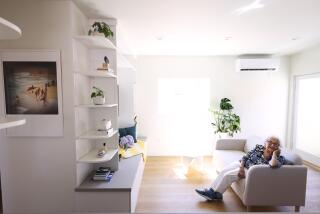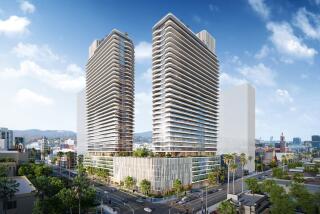Westwood Towers Reflect the Drift of Office Design
Westwood was never meant to be an office center dominated by high-rise towers. Rather it was to be a college town in the Arcadian dream of Los Angeles as a mosaic of well-landscaped small towns.
But because of weak planning that did not anticipate the growth of the city, the avaricious nature of development and the attraction of Westwood itself as a place to work and live, Wilshire Boulevard, just east of Interstate 405, the San Diego Freeway, has become one of the more desirable office markets in the region.
A result--in addition to (almost daily) traffic gridlock--is that the stretch of Wilshire there has become a place to view the drift of design of office towers as architecture. (As for whether the towers of such height and size should have been built there at all is a larger planning and political issue for debate elsewhere.)
Until recently, most of the high rises that have risen in Westwood have been exercises in the Modern-style mold: boxy and boring, cold and corporate. Take a look at, among others, 10880 Wilshire, as well as 10960, and the Federal building at 11000 and shiver.
More friendly is Westwood Place, at 10866 Wilshire Blvd., which opened last summer. It is a well-detailed, 15-story structure, tucked in at the southeast corner of Glendon Avenue to create a bright, marble-encrusted lobby and stepped back at the upper floors to create 12 desirable corner offices. The corner tuck and the cascading effect at the roof line reinforces the building’s verticality and lends interest, if not a little confusion, to its massing and siting.
Engaging also, but almost to the point of distraction, is the polished red-granite facade, and oversize, accented, tinted windows, edged by dark-green strips of bronze. While somewhat overdesigned by architect Harshad Patel of the former firm of Maxwell Starkman & Associates (Patel now heads his own firm and Starkman has been reorganized), Westwood Place is a welcome contrast to its bland neighbor across the street, the glass and steel MCO monolith.
Also well-detailed in a polished red granite and windows of green-tinted glass, but in a more subdued style than Westwood Place, is the 17-story One Westwood building, at the southeast corner of Wilshire Boulevard and Veteran Avenue. It was designed with a touch of elegance by the Landau Partnership and opened a few months ago.
However, sited as it is on Wilshire Boulevard and skewed to maximize views at a very exposed corner, the building and, particularly its lobby when approached from the west, seem awkward. Given the exposed site, perhaps something more dramatic would have been more appropriate. As it is, One Westwood is a fine but anonymous building.
Definitely not anonymous, and making what I feel is one of the strongest architectural statements in Los Angeles since the Pacific Design Center, is The Tower at 10940 Wilshire Blvd. Scheduled to be completed in a few months, the soaring 23-story building seems to be trying to twist up and out of its structural system and tight site, while nodding to the adjoining buildings and the city beyond.
As if the thrusting octagonal-shaped, flared towers juxtaposed with a sloping, central, rectangular-shaped mass do not clash enough, the facade is composed of buff-colored limestone and green granite, with dark gray glass windows, framed by blue-green mullions organized into horizontal bands and vertical shafts.
The mix of shapes, materials and colors of the twisted tower may not sound appealing, but it looks striking, especially when seen looking south from Westwood Village. The total, I feel, captures and reflects in a bold architectural pronouncement the tone and contradictions of contemporary L.A.
Designed with characteristic flair by architect Helmut Jahn of the Chicago-based firm of Murphy/Jahn, the building appears to be a futuristic version of an Art Deco-styled tower, replete with exaggerated, angled exterior fixtures for uplighting. I am sure King Kong would have felt comfortable scaling it.
The twisted tower, along with Westwood Place and One Westwood, does much to brighten and make more architecturally interesting the wall of office towers edging the south side of Wilshire Boulevard. But nonetheless it remains a wall.
More to Read
Sign up for Essential California
The most important California stories and recommendations in your inbox every morning.
You may occasionally receive promotional content from the Los Angeles Times.






